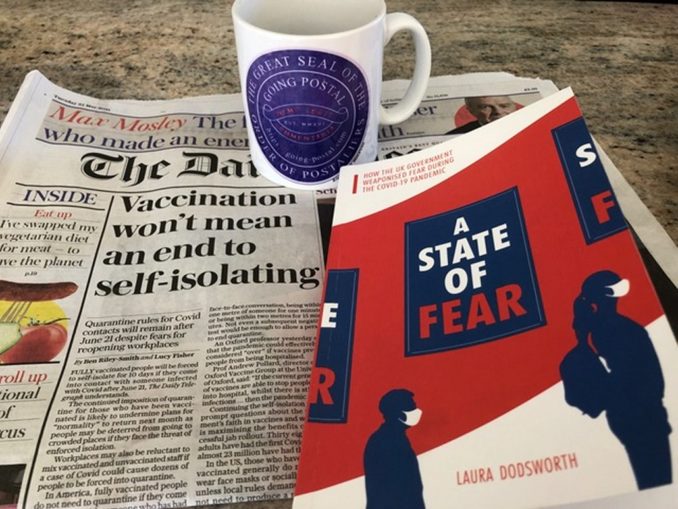
Mid-February, 2020: My wife and I stayed at our favourite hotel on the South Devon coast. There was a woman there who was coughing a bit, actually quite a lot; we didn’t think too much of it. We’ll call her Mrs Coffsalot. We knew there was news of a virus in the far east, but we thought … well, we didn’t really think too much about it.
Early March 2020: We stayed at the Summer Lodge Hotel & Spa for the first anniversary of our wedding. It was a wonderful stay. If you can run to it, we really cannot recommend the place enough. It has a world class sommelier. We had an eight-course taster menu. My wife treated me to a whisky tasting experience.
I started to feel a bit rough during this trip. My scalp felt tight and prickly and I started to feel a bit not good. I’m coming down with something, I thought. I didn’t make any connection with the virus, at all. My mood was not improved at all the next and final morning of the trip to find that the financial markets had decided to remove a metric f-tonne of value from my position. Even then, I didn’t make the connection.
I spent the next day and-a-half in bed. I really wasn’t happy, at all. The day after, I was completely back to normal. Even after, it was weeks before either of us wondered if I’d come down with the Chinese Flu. Did I get the lurgy, and if I did, did I catch it of Mrs Coffalot? Who knows, and indeed, who cares, really. We didn’t even consider it.
Which might seem strange, because in the second week of March, we decided to become early adopters of the new “social distancing” (how easily such hateful expressions fall into common usage). We’d read enough to become very concerned. We decided not to attend our village pantomime, even though we had paid for the tickets. We made our own risk assessments; we did not outsource them to others.
Some of our neighbours looked askance at us. They thought we were over the top.
Some of these same neighbours (actually, far too many of them) would, later, do almost perfect impersonations of applauding seals each Thursday at 8PM when told they should by the media and perhaps by peer pressure, to celebrate the sainted rNHS.
And this is what this book is all about. Why did so many people fall for the narrative? Why were so many so readily manipulated? In our lifetimes, we are unlikely to get to the heart of the matter, and sadly, many people simply do not care, and yet Dodsworth’s piece is probably our best shot of doing so, and thus is essential reading. I firmly believe it will come to be seen as one of the most important books of our times.
“A State of Fear”, by Laura Dodsworth
If you’re expecting a quick read, forget it. Laura Dodsworth certainly does not do things by halves. She has a fluid and compelling writing style that demands the reader’s full attention, and she is on top of her brief. She has interviewed hundreds of people up and down the country to gain valuable insights into the scale of the deception that the government and a very compliant media has wreaked upon the country.
The opening chapter, entitled Fright Night, covers the events of the evening of Monday, the 23rd. You will probably remember this period very well…I certainly do. The preceding Friday, March 20th, my wife and I had just returned from what would turn out to be our last hotel stay for months and were in our local pub, when the Prime Minister made his first “stay at home” speech. On the following Monday, he made a much more impactful speech. Laura Dodsworth, with help from two experts, one of them a clinical psychologist, provides a detailed forensic analysis of Johnson’s body language and style of speech for this second address. Both experts concluded, unprompted, that Johnson did not himself believe that which he was telling the country to believe. The speech itself is analysed for linguistics, and the conclusion drawn that the speech was crafted by others in Johnson’s coterie to immediately ramp up the fear.
Dodsworth, throughout the book, uses the clever literary device of interviewing ordinary people to reinforce her message. In concluding the opening chapter, Darren, 64, a retired armed police officer from Liverpool, tells of how through watching the relentless doom coverage on TV, he became terrified to the point of barely being able to cope, indeed becoming agoraphobic in his fear.
The book goes on to cover in depth the role that the media has played throughout the crisis, and predictably, some very disturbing information emerges. Dodsworth talks about the role the Chinese 50-cent twitter army played in ensuring that the West would adopt totalitarian methods. Apparently, the Chinese Communist Government pays between 250,000 and 2 million of its citizens to put out pro-government propaganda out on Western social media, posing as Westerners, at 50 cents a pop. She goes on to discuss the way our largely debauched media only too willingly goes along with the government line, and not only this, does not carry out even a bare minimum of fact checking for stories put out either by our own government or others. Death porn generates clicks and sells copy, it seems, the later retractions, if they ever appear, less so. It also emerges that Public Health England became the UK’s largest print media advertiser during FY20-21, with the UK Government at sixth place. She ends the chapter with an analysis of the deeply troubling OfCom position on the inhibition of free speech where it collides with the official line on Covid.
A detailed overview of the history of governments’ use of fear and propaganda is provided. Although it has been used for millennia by the powerful to control the weak, Dodsworth sees several points in history where the pace has accelerated. She cites the Cold War, 9/11 and the Islamist terror attacks in the UK as the most recent of these. This part of the book focuses on the UK and other governments’ attempts to demonise dissenters (such as us) and herself (she describes a particularly disgraceful incident in which she was bullied and harassed by thugs-in-police-uniforms at an anti-lockdown event in Central London, where she was attempting to do her job as a journalist. The issue of official and media treatment of vaccine refuseniks is also discussed in some depth.
The author then expounds, in chilling detail, how “nudge theory” works in the UK Government. Apparently, HMG is one of the leading pioneers in this, and it is now a growth and export industry, while the Behavioural Insights Team set up by David Cameron in 2010 has become a for-profit limited company, exporting its “product” to other governments world-wide. Dodsworth reveals a fascinating encounter with BIT, in which its communications director tried to neutralise her by flattery and the lure of a possible contract for a creative project to showcase their work. In this chapter, she also reveals that there are many sources within No 10 and elsewhere in government who are very unhappy with what is going on, but who are, of course very fearful of losing employment should they speak out. Some of these posit that the real motivation for fearmongering is political rather than practical. The Conservatives had just won an election with the central plank of the NHS, so of course the NHS had to be seen to be protected, at all costs. The toe-curlingly dreadful “Clap for Carers” is also given some coverage, again as a means of manipulating public sentiment, this time through tribalism.
I’m very glad to be able to say that my wife and I did not clap, at all. To have done so would have been a negation of principle. I daresay many of my readers feel the same. It was, however, depressing for us to see how many of our neighbours did clap.
The clapping is explored in more depth on the chapter devoted to the inner workings of SPI-B, the subcommittee reporting to SAGE whose members are behaviouralists, anthropologists and specialists in social and healthcare psychology, responsible for devising methods to control public behaviour. Dodsworth secured interviews with several members of SPI-B, two of them under condition of anonymity. It is striking that the two who did not want to be identified were the most critical of the dubious ethics behind the fear-mongering, and in particular, of the “Clap for Carers” programme. One of them said the following:
“I never joined in. I was relieved when it was over. I would say it was “created”, invented, I don’t think it was grass-roots. We never discussed it in SPI-B, it wasn’t our policy or recomendation, I just think someone, somewhere, dreamt it up. It was ready to go. Something about it struck me as artificial. I bristled at the rainbows in people’s windows. I think the government used it as a shield.
From this it is clear that SPI-B is far from unanimous in its views, and therefore there is no consensus in its policy recommendations. Some of its members, it seems, feel very uncomfortable with how events have played out. One of the members, Gavin Morgan resisted the imposition of masks in schools, and found that his influence within the team seemed diminished as a consequence.
SPI-B appears to be dominated by two people, Clifford Stott, a Professor of Social Psychology at Keele University (interviewed by the author) and Susan Michie, Professor of Health Psychology at UCL (not interviewed). Stott is an ardent believer in so-called climate change and is on record as advocating similar methods to nudge the public’s response to governments’ attempts to control climate change as used to nudge public behaviour during the epidemic. This should immediately ring alarm bells, at full volume. Michie is a member of the Communist Party of Britain, which seeks in its manifesto to replace capitalism with a socialist command economy. Overall, most of SPI’s members are liberal-left academics, with more centrist or centre-right points of view rarely getting a look-in. As such, they embrace a collectivist perspective, very much evidenced by their policy recommendations. Gavin Morgan, the only dissenter willing to be named, said that on the subject of masks, many in the SPI-B group favour masks precisely because they increase the sense of collectivism in the wearers (we’re all in this together). Morgan himself clearly stated, rather bravely in the circumstances, that “masks dehumanise people”.
My wife and I wore masks briefly, before they became mandatory, and once made a legal requirement, swapped them for exemption lanyards. We find them to be disgusting, likely to make the problem worse not better, and like Gavin Morgan, dehumanising and degrading. We see them as a means to further control and intimidate the public into submission.
And we have met many people who dissent as we do, and object to all of this. Some of these people we know from attending various Going Postal events, both formal and informal. Others are trades people who come to our house. Some of these are bolder than others; some of them need no encouragement at all to air their views, others do need a little, but once given, the flood-gates open, and they don’t hold back. I have heard from several people in this latter category that they regard the whole effort as a means to exert control.
This is less than half the book covered; there is much more to come, soon. Watch this space, and ideally, get your copy of the book using Going Postal’s Amazon link.
© text & image Martin Mezger 2021
The Goodnight Vienna Audio file
Audio Player



